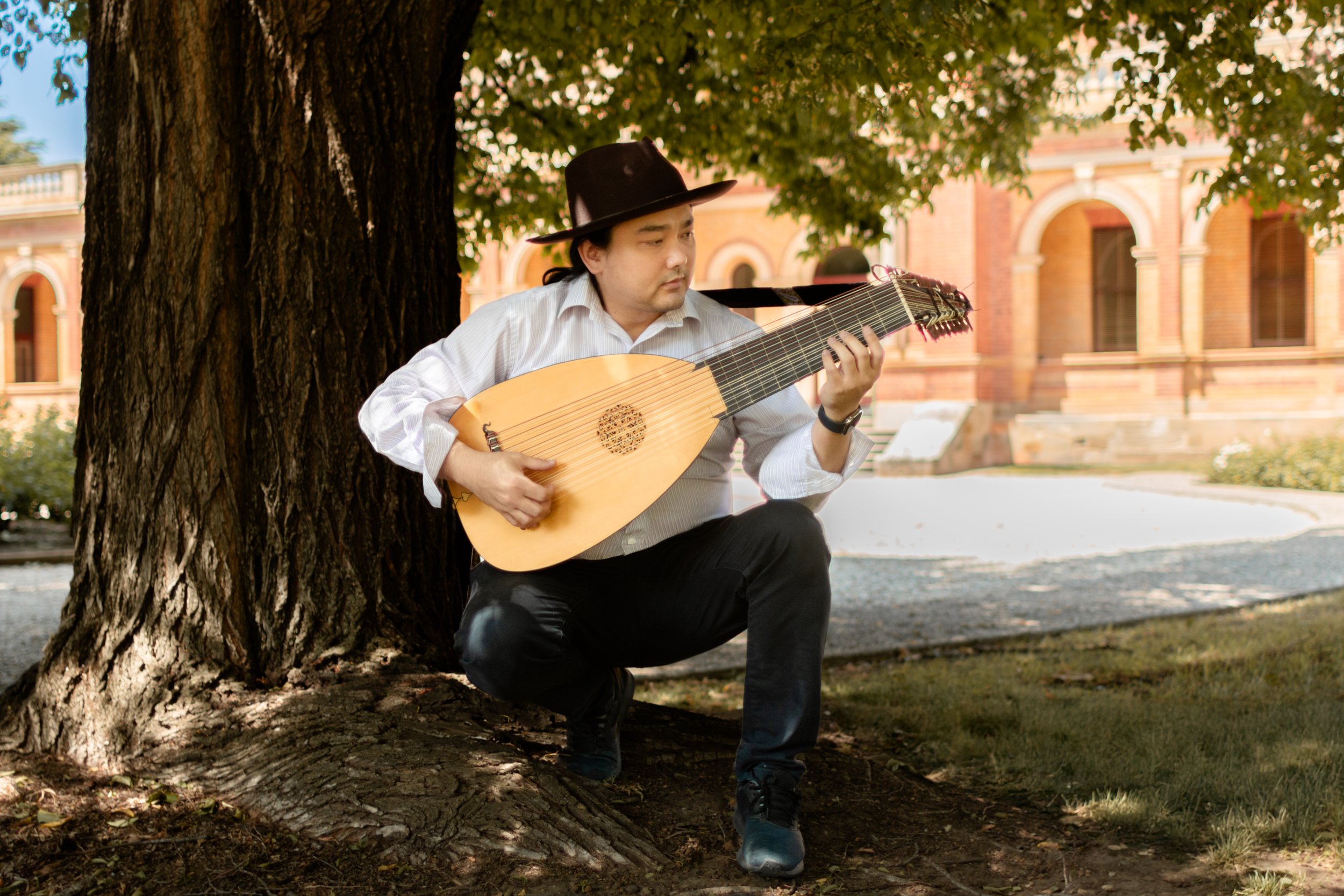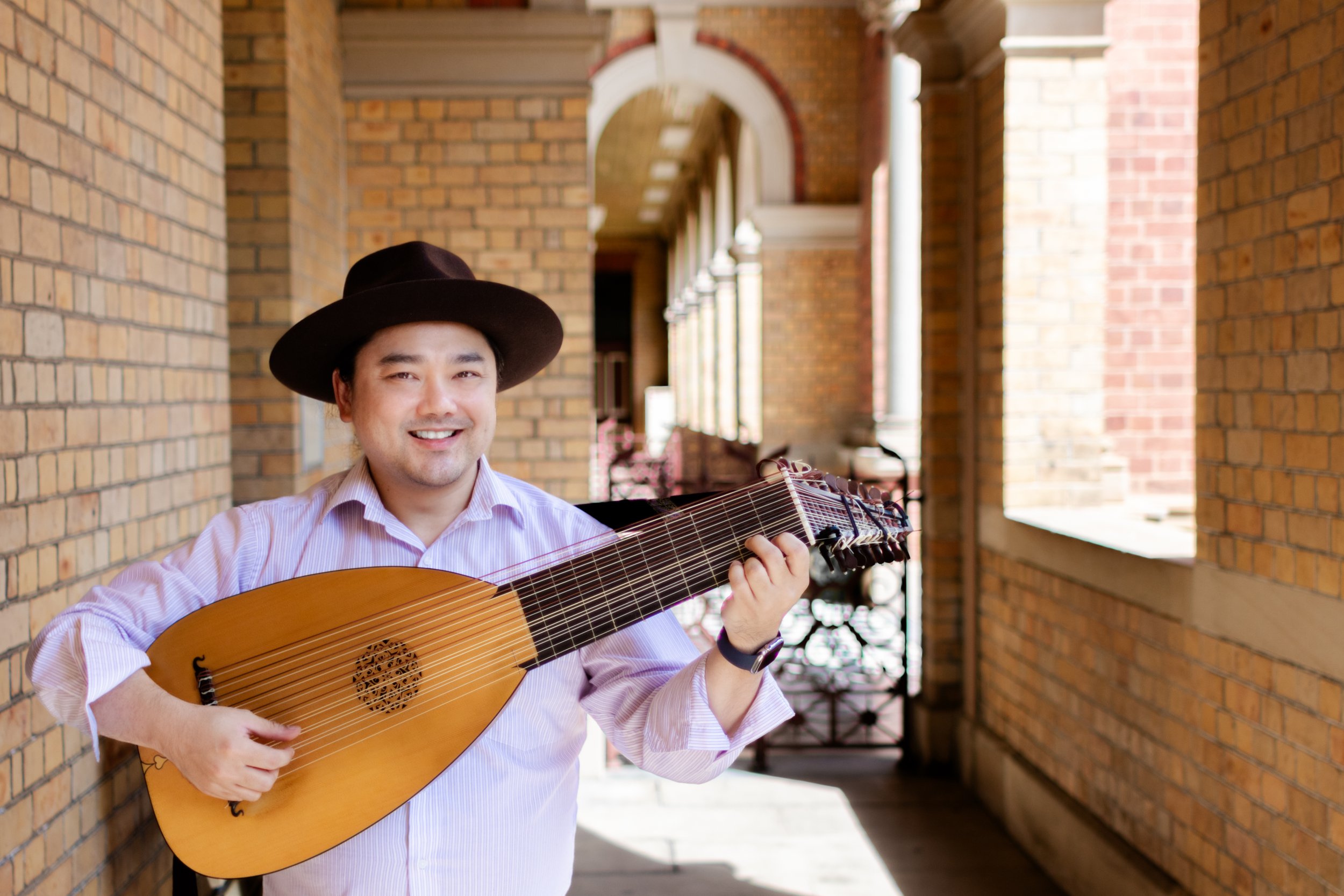Echoes of Love and Lost: French Baroque Lute Masterpieces
Music by Dubut, Dufault, Gallot and Gaultier
Shaun Ng, 11-course baroque lute
Ennemond Gaultier
1 Chaconne
Jacques Gallot
2 Prelude
3 Allemande l'Amant Malheureux
4 Canarie les Castagnettes
5 Gavotte la Jalousée
François Dufault
6 Prelude
7 Courante
8 Double
9 Sarabande
10 Gigue
Ennemond Gaultier
11 Prelude
12 Tombeau de Mezangeau
13 Gigue
14 Sarabande
15 Canaries
Pierre Dubut
16 Prelude
17 Allemande
18 Courante
19 Sarabande
20 Chaconne
Recorded in July 2024 (Dufault, Gaultier) and Oct 2024 (Dubut, Gallot) at A415 Studios, Newington
Recorded, edited and mastered by A415 Music
Photography at Goulburn Court House, Goulburn NSW, by HanGyu Lee
Artwork by A415 Music
11-course baroque lute by Jason Petty (Wellington, New Zealand, 2013)
Lute strings by Aquila Corde Armoniche
Pitch at a'=392Hz
© A415 Music 2025 CD009
Echoes of Love and Lost invites the listener into a sound world shaped by intimacy, memory, and emotional ambiguity. The title itself is a deliberate poetic departure—suggesting not just the act of losing, but the lingering, uncertain state of being lost in the aftermath of love.
Tis better to have loved and lost than never to have loved at all.
Alfred, Lord Tennyson
Echoes of Love and Lost invites the listener into a sound world shaped by intimacy, memory, and emotional ambiguity. The title itself is a deliberate poetic departure—suggesting not just the act of losing, but the lingering, uncertain state of being lost in the aftermath of love. Like the refined elegance of French Baroque music, where emotion is woven through ornamentation, subtle dissonance, and graceful restraint, these works speak in sighs and shadows. Each prelude, allemande, and chaconne becomes a fragment of something once cherished, now echoing through time. This recording is not a lament, but a quiet wandering—a meditation on how love transforms us, and how its absence leaves us beautifully undone.
A Brief History
The European Renaissance lute had existed in various forms since at least the 15th century, but it was in France during the first half of the 17th century that the instrument underwent a transformation. The Renaissance lute was extended to eleven courses, and its tuning was altered from the vieil ton (G-c-f-a-d’-g’) to the new D-minor accord nouveau (A-d-f-a-d’-f’). This new tuning allowed the player to produce a commonly used chord with open strings, facilitating the rich and expressive harmonies characteristic of the Baroque period.
Additionally, the top string or chanterelle was lowered from G to F, enabling the construction of larger lutes capable of producing deeper, more resonant tones. This preference for lower pitches can be seen across French instrument-making of the time, with extant woodwind and keyboard instruments tuned as much as a tone below modern pitch. The French eleven-course lute remained dominant until the early 18th century, when German lutenists further expanded its range, increasing the instrument’s size, string length, and bass courses to create the thirteen-course lute.
It was during the mid-seventeenth century that this characteristic style of French lute music emerged. Later described by 20th-century scholars as style brisé (broken style), this performance technique is defined by the asynchronous playing of chords, creating an effect reminiscent of counterpoint. Unlike keyboard instruments, which can sound multiple notes simultaneously, the lutenist’s right hand typically plucks notes in succession, using the thumb and fingers in various combinations.
Composers sometimes indicated the order in which these notes should be plucked, but more often, the decision was left to the performer. The most common approach involved the thumb plucking the bass note while the remaining fingers articulated the upper notes, either in succession or simultaneously where practical. For chords spanning three or four notes, the thumb, index, and middle fingers were commonly used, though the ring finger—while possible—was rarely employed in historical sources. For more extensive arpeggiation, the player could either repeat the use of the thumb or employ the index finger in a strumming motion (rasgueado) before concluding with the middle finger, which, being closest to the bridge, produced a distinctively nasal and projecting tone.
The works featured in this recording span roughly 50 years, from the mid-17th century to the century’s end, representing some of the most influential composers of the French lute school.
Ennemond Gaultier (c.1575–1651)
Ennemond Gaultier, often referred to as Gaultier le Vieux (the Elder), is widely regarded as a founding figure of this refined style. While most of his music survives in manuscript form, a selection of his works was published by his cousin Denis Gaultier in the Livre de tablature des Pièces de Luth (Paris, c.1680). This recording includes several of his compositions, most notably the monumental Tombeau de Mezangeau [sic], a musical eulogy for the lutenist René Mésangeau, who is believed to have been Gaultier’s teacher. This piece is the earliest known example of the tombeau, a genre that would later be embraced by both lutenists and viola da gamba players as a means of musical commemoration.
François Dufault (c.1604–before 1682)
François Dufault is thought to have studied with Denis Gaultier. Only twelve of his pieces were published in Tablature de luth de différents autheurs sur des accords nouveaux (P. Ballard, 1631), but many more survive in manuscript sources across European libraries. His music reflects the elegance and expressiveness of the French lute tradition, with highly ornamented melodies and intricate harmonic textures.
Pierre Dubut (fl. mid-17th century)
Little is known about Pierre Dubut, but like Dufault, his works are found in various manuscript collections. His music follows the conventions of the period, characterised by expressive harmonic progressions and finely crafted dance forms.
Jacques Gallot (c.1625–after 1695)
Jacques Gallot, a slightly later figure in this lineage, was one of the most distinctive composers of the French lute school. His most significant publication, Pièces de luth composées sur differens modes (Paris, c.1670), contains a mixture of dance movements and evocative programmatic pieces. Unlike his predecessors, Gallot frequently assigned descriptive titles to his works, such as L’Amant Malheureux (The Unhappy Lover) and La Jalousée (The Jealous One), both of which are included in this recording. These titles suggest a more overtly expressive, almost narrative approach to composition, reflecting the broader trend of musical rhetoric in the late 17th century.



SHAUN NG
Shaun Ng has established himself as one of Australia’s most versatile early musicians, excelling as a performer on the violin, viola da gamba, and lute families. He received his musical training at the Royal Welsh College of Music and Drama, the Conservatorium of Amsterdam, the University of Western Australia, and the Sydney Conservatorium of Music, where he was awarded the Australian Postgraduate Award to pursue a Doctor of Musical Arts in Historical Performance and Musicology.
Shaun’s principal lute teachers include Tommie Andersson, Lucas Harris, and Xavier Diaz-Latorre. He has further honed his craft by participating in prestigious early music seminars and conferences such as the Oberlin Conservatory’s Baroque Performance Institute, the Tafelmusik Baroque Summer Institute, and the Lute Society of America Seminars. These experiences allowed him to work with renowned lutenists like Nigel North, Jakob Lindberg, and Robert Barto, among others.
As an active freelance performer, Shaun has collaborated with many ensembles across Australia. Recent highlights include performances with The Marais Project, HIP Company, and the Canberra Bach Ensemble. Since 2023, he has co-led the Early Music Collective Sydney alongside Karen Carey OAM, contributing to the promotion and performance of historically informed music.
In addition to his performing career, Shaun is a dedicated teacher. He maintains a vibrant private teaching studio and works with several schools in Sydney, nurturing the next generation of musicians in violin, viola da gamba, and lute performance.
Shaun also runs the record label A415 Music, dedicated to historically informed recordings of early music. Visit his website at shaunng.com for more information.


